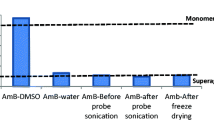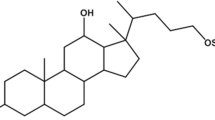Abstract
The pharmacokinetic profiles of amphotericin B (AmB) after administration of Amphocil®, an AmB/cholesteryl sulfate colloidal dispersion (ABCD) and the micellar AmB/deoxycholate (Fungizone®) were compared after repeated dosing in rats. After administration of ABCD and Fungizone at an equal AmB dose (1 mg/kg), AmB concentrations in plasma and most tissues were lower for the ABCD dose, especially in the kidneys where reduced drug concentration correlated with reduced nephrotoxicity. In contrast, AmB concentrations in the liver were substantially higher when ABCD was administered; however, without an accompanying increase in hepato-toxicity. Daily administration of ABCD for 14 days did not lead to AmB accumulation in plasma; while a slight accumulation was observed after multiple administration of Fungizone. AmB was eliminated more slowly from the plasma and various tissues and urinary and fecal recoveries of AmB were reduced after ABCD administration. These results suggest that ABCD may be stored in tissues in a form that is less toxic and is eliminated from the systemic circulation by a different mechanism than the free and protein-bound AmB in plasma. AmB accumulation in the spleen was observed when higher doses of ABCD (5 mg/kg) were administered, which could be due to saturation of hepatic uptake of AmB. Comparison of spleen concentrations of AmB between ABCD and Fungizone® at 5 mg/kg AmB doses was not possible because of Fungizone's toxicity in rats. In all other organs, AmB concentrations reached or approached a steady state within two weeks of dosing with ABCD. Urinary and fecal clearances of AmB were not different between ABCD and Fungizone administration. In summary, the distribution and elimination characteristics of AmB in rats were substantially altered when it was administered as ABCD in comparison to Fungizone. Nephrotoxicity of AmB in rats was reduced after administration of ABCD apparently because of the altered tissue distribution pattern. Thus, ABCD (Amphocil®) may be a clinically beneficial formulation of AmB in patients with systemic fungal infections.
Similar content being viewed by others
REFERENCES
H. A. Gallis, R. H. Drew, and W. W. Pickard. Amphotericin B: 30 years of clinical experience. Rev. Infect. Dis. 12: 308–329 (1990).
G. A. Sarosi. Amphotericin B still the “gold standard” for antifungal therapy. Postgrad. Med. 88: 151–166 (1990).
R. L. Juliano, G. Lopez-Berestein, R. Hopfer, R. Mehta, K. Mehta, and K. Mills. Selective toxicity and enhanced therapeutic index of liposomal polyene antibiotics in systemic fungal infections. Ann. N. Y. Acad. Sci. 446: 392–402 (1985).
R. L. Taylor, D. M. Williams, P. C. Craven, J. R. Graybill, and D. J. Drutz. Amphotericin B in liposomes: A novel therapy for histoplasmosis. Am Rev. Respir. Dis. 125: 610–611 (1982).
J. Brajtburg, W. G. Powderly, G. S. Kobayashi, and G. Medoff. Amphotericin B: delivery systems. Antimicrob. Agents Chemother. 34: 381–384 (1990).
J. M. Clark, R. R. Whitney, S. J. Olsen, R. J. George, M. R. Swerdel, L. Kunselman, and D. P. Bonner. Amphotericin B lipid complex therapy of experimental fungal infections in mice. Antimicrob. Agents Chemother. 35: 615–621 (1991).
N. I. Payne, R. E. Crosgrove, A. P. Green, and L. Liu. In-vivo studies of amphotericin B liposomes derived from proliposomes: effect of formulation on toxicity and tissue disposition of the drug in mice. J. Pharm. Pharmacol. 39: 24–28 (1987).
G. Lopez-Berestein, G. P. Bodey, L. S. Frankel, and K. Mehta. Treatment of candidiasis with liposomal-amphotericin B. J. Clin. Oncol. 5: 310–317 (1987).
J. Tollemar, O. Ringden, and G. Tyden. Liposomal amphotericin B (AmBisomeR) treatment in solid organ and bone marrow transplant recipients. Efficacy and safety evaluation. Clin. Transplant. 4: 167–175 (1990).
T. F. Patterson and V. T. Andriole. The role of liposomal amphotericin B in the treatment of systemic fungal infections. Eur. J. Cancer Clin. Oncol. 25: 563–568 (1990).
R. T. Proffitt, A. Satorius, S.-M. Chiang, L. Sullivan, and J. P. Adler-Moore. Pharmacology and toxicology of a liposomal formulation of amphotericin B (AmBisome) in rodents. J. Antimicrob. Chemother. 28(Suppl. B): 49–61 (1991).
F. Meunier, H. G. Prentice, and O. Ringden. Liposomal amphotericin B (AmBisome): safety data from a phase II/III clinical trial. J. Antimicorb. Chemother. 28(Suppl. B): 83–91 (1991).
L. S. S. Guo, R. M. Fielding, D. D. Lasic, R. L. Hamilton and D. Mufson. Novel antifungal drug delivery: stable amphotericin B-cholesteryl sulfate discs. Int. J. Pharmaceutics 75: 45–54 (1991).
R. M. Fielding, M. S. Newman, and L. S. S. Guo. Abtr. Am. Soc. Pharmacol. Exp. Ther. 41st Annual Meeting. Abstract No. 176 (1990).
K. V. Clemons, A. M. Perlman, L. H. Hanson, and D. A. Stevens. Abtr. Int. Congr. infect. Dis. Abstract No. 389, p. 39 (1990).
R. M. Fielding, P. C. Smith, L. H. Wang, J. Porter, and L. S. S. Guo. Comparative pharmacokinetics of amphotericin B after administration of a novel colloidal delivery system, ABCD, and a conventional formulation to rats. Antimicrob. Agents Chemother. 35: 1208–1213 (1991).
R. M. Fielding, A. W. Singer, L. H. Wang, S. Babbar, and L. S. S. Guo. Relationship of pharmacokinetics and tissue distribution to increased safety of colloidal amphotericin B in dogs. Antimicrob. Agents Chemother. 36: 299–307 (1992).
A. C. Parekh, R. J. Creno, and C. V. Dave. Hypocholesterolemic effect of amphotericin B: an analytical approach. Res. Commun. Chem. Pathol. Pharmacol. 9: 307–314 (1974).
D. M. Cocchetto and T. Bjornsson. Methods for vascular access and collection of body fluids from the laboratory rat. J. Pharm. Sci. 72: 465–492 (1983).
L. H. Wang, P. C. Smith, K. L. Anderson, and R. M. Fielding. HPLC analysis of amphotericin B in plasma, blood, urine, and tissues for pharmacokinetic and tissue distribution studies. J. Chromatogr. 579: 259–268 (1992).
I. L. Smith and J. J. Schentag. Noncompartmental determination of the steady-state volume of distribution during multiple dosing. J. Pharm. Sci. 73: 281–282 (1984).
R. G. Meeks. The rat. In W. F. Loeb and F. W. Quimby (eds.) The Clinical Chemistry of Laboratory Animals, Pergamon Press, New York, Chapter 2, p. 19–25 (1989).
G. Lopez-Berestein, M. Rosenblem, and R. Mehta. Altered tissue distribution of amphotericin B by liposomal encapsulation: Comparison of normal mice to mice infected with Candida albicans. Cancer Drug Delivery 1: 199–205 (1984).
F. C. Szoka, D. Milholland, and M. Barza. Effect of lipid composition and liposome size on toxicity and in vitro fungicidal activity of liposome-intercalated amphotericin B. Antimicrob. Agents Chemother. 31: 421–429 (1987).
L. E. Edmonds, L. Davidson, and J. S. Bertino. Solubility and stability of amphotericin B in human serum. Ther. Drug Monit. 11: 323–326 (1989).
E. D. Block, J. E. Bennel, L. G. Livoti, W. J. Klein, R. R. MacGregor, and L. Henderson. Flucytosine and amphotericin B: Hemodialysis effects on the plasma concentration and clearance. Ann. Int. Med. 80: 613–617 (1974).
T. Patterson, P. Miniter, J. Dijkstra, F. Szoka, J. Ryan, and V. Andriole. Treatment of experimental invasive aspergillosis with novel amphotericin B/Cholesterol-sulfate complexes. J. Infect. Dis. 159: 717–724 (1989).
P. C. Craven, T. M. Ludden, D. J. Drutz, W. Rogers, K. A. Haegele, and H. B. Skrdlant. Excretion pathways of amphotericin B. J. Infect. Dis. 140: 329–341 (1979).
R. Lawrence, P. Hoepich, F. Jagdis, N. Monji, A. Huston, and C. Schaffner. Distribution of doubly radiolabelled amphotericin B methyl ester and amphotericin B. J. Antimicrob. Chemother. 6: 241–249 (1980).
H. Kim, D. Loebenberg, A. Marco, S. Symchowicz, and C. Lin. Comparative pharmacokinetics of Sch 28191 and amphotericin B in mice, rats, dogs, and Cynomoigus monkeys, Antimicrob. Agents Chemother. 26: 446–449 (1984).
W. H. Beggs. Antioxidant stabilized amphotericin B. Diagn. Microbiol. Infect. Dis. 1: 339–341 (1983).
Author information
Authors and Affiliations
Rights and permissions
About this article
Cite this article
Wang, L.H., Fielding, R.M., Smith, P.C. et al. Comparative Tissue Distribution and Elimination of Amphotericin B Colloidal Dispersion (Amphocil®) and Fungizone® After Repeated Dosing in Rats. Pharm Res 12, 275–283 (1995). https://doi.org/10.1023/A:1016243313027
Issue Date:
DOI: https://doi.org/10.1023/A:1016243313027




